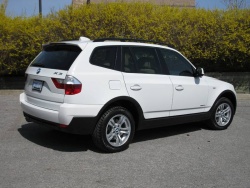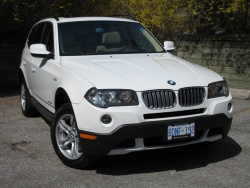 2010 BMW X3 xDrive28i. Click image to enlarge |
|
Related articles on Autos
Manufacturer’s web site
|
Review and photos by Jil McIntosh
Find this vehicle in Autos’s Classified Ads
Photo Gallery:
2010 BMW X3
It is indeed possible to have too little of a good thing. That’s the case with BMW’s new-for-2010 X3 xDrive28i: you pay less, and you still get all the handling prowess that originally saw the X3 setting the standard for SUV sportiness, but its engine detuning cuts sharply into its performance without returning any benefit at the fuel pumps.
The X3 is scheduled for a complete makeover, but for now, BMW is offering the xDrive28i to the Canadian market, alongside the xDrive30i that was the only choice for 2009. Realizing that Canadian and American buying choices are not identical, the company has carved out a unique Canuck approach: the xDrive28i is not available south of the border, and all X3 models come strictly with a six-speed automatic, while American buyers can also order a stick shift. Given that most typical midsize SUV buyers aren’t really the row-your-own-gears type, I’m surprised it’s even still available in that market.
 2010 BMW X3 xDrive28i. Click image to enlarge |
Although the names would lead you to think otherwise, the 2.8i and 3.0i both use a 3.0-litre inline six-cylinder engine. The difference is in the power: the 3.0i coaxes 260 horsepower and 225 lb-ft of torque out of it, while the 2.8i produces 215 horsepower and 185 lb-ft of torque. We’ve seen this before: for 2008, the 215-horsepower was named the 3.0i, while the 260-horsepower version was called the 3.0si. Fuel consumption doesn’t change between the two, standing firm at 12.2 L/100 km (23 mpg Imp) in the city, and 8.3 (34) on the highway; in combined driving, I averaged 11.2 (25). Premium fuel is “highly recommended,” according to the owner’s manual, although it says the vehicle will run on 87-grade regular fuel.
There’s also a detuning in the features department, which helps to explain the 28i’s starting price of $39,900, versus the $45,900 it will take to get into the 30i. The 28i includes 17-inch alloy wheels, manual air conditioning, “leatherette” manually-adjustable heated seats, rain-sensing wipers, six speakers and automatic headlamps, among other items, but the 30i adds 18-inch wheels, automatic climate control, eight-way power seats, eight speakers, BMW Assist and Bluetooth, along with a panoramic sunroof and heated steering wheel. Those last two are the only options that can be added to the 28i, bundled into an Executive Edition package for $1,100. The other extras from the 30i aren’t available on the 28i – understandable, given that there has to be something to sweeten moving up by $6,000, although I might have expected the Bluetooth as an add-on to the 28i. (Not that its absence is a bad thing: it’s the call, not the type of phone, that’s the hazard while driving.)
  2010 BMW X3 xDrive28i. Click image to enlarge |
Colours are also limited: while the 30i comes in a choice of seven shades, the 28i is restricted to white, black or grey.
The drop in power wouldn’t be so bad on its own, but it definitely doesn’t reach its full potential. Instead of being linear, the throttle has a lag when you put down your foot: you get a couple of beats of indecision before the vehicle scoots away. The shifts are jerky, too, and while you can slap the shifter sideways and up- or downshift yourself for smoother transitions, the manual shift mode should complement the transmission, not make up for its shortcomings.
The xDrive in the clunky name refers to the all-wheel system, the only configuration available on the X3. It’s a brilliant slice of technology and a major factor in why the vehicle handles as well as it does. Maintaining a rear-end bias under normal conditions, it almost instantaneously transfers power to the front or the rear axle as needed, not just for slippery surfaces, but for better handling on dry roads, offsetting understeer or oversteer when required. The feel at the wheel is classic BMW: sprightly turn-in, smooth return, and your know-it-all teenager doesn’t talk back to you as much as these front wheels do when they’re describing the road surface. The stiff chassis eliminates almost all of the body roll, and once you’re past the throttle lag, it’s fun to toss this machine into corners – something you really don’t expect to be able to do with a sport utility vehicle.







 Follow Autos on Twitter
Follow Autos on Twitter



